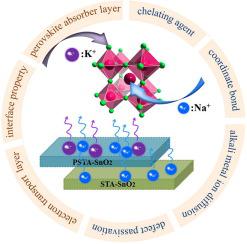Chemical Engineering Journal ( IF 13.3 ) Pub Date : 2020-10-18 , DOI: 10.1016/j.cej.2020.127387 Yansen Sun , Zhenyu Pang , Yingnan Quan , Donglai Han , Xinyuan Zhang , Xin Ge , Fengyou Wang , Yunfei Sun , Jinghai Yang , Lili Yang

|
The diverse defects within perovskite film, electron transport layer (ETL) and their interface greatly impair the power conversion efficiency (PCE), hysteresis and stability of perovskite solar cells (PSCs). Herein, we propose a synchronous defect passivation strategy by introducing chelating agent containing movable alkali metal cations, i.e. sodium tartrate (STA)/potassium sodium tartrate (PSTA) into SnO2 aqueous colloidal dispersions to realize the efficient regulation of ETL, perovskite layer and their interface properties. That is, the chelating function and existence of alkali metal ions in additives leads to uniform, less defective and highly conductive SnO2 ETLs, which provides outstanding platforms for depositing perovskite films with high-quality crystallinity to improve the interfacial charge transfer. In particular, a part of Na+ and K+ ions of additives can enter into perovskite film through thermal diffusion and passivate the defects by coordinating with under-coordinated halides via ionic interactions or electrostatic adsorption on the negative charged defects at surface and grain boundaries. Such synchronous optimization for ETLs, perovskite and their interface enables the realization of high power conversion efficiencies (PCEs) of 20.38% and 21.14% with reduced hysteresis and improved stability for STA-SnO2 and PSTA-SnO2 based PSCs, respectively. This work greatly simplifies the defect passivation process and provides a promising low-cost technique for large-scale manufacturing efficient and stable planar PSCs.
中文翻译:

用于构造高性能且稳定的平面钙钛矿太阳能电池的同步缺陷钝化策略
钙钛矿薄膜,电子传输层(ETL)及其界面内的各种缺陷极大地损害了钙钛矿太阳能电池(PSC)的功率转换效率(PCE),滞后性和稳定性。本文中,我们提出了一种同步缺陷钝化策略,方法是将包含可移动碱金属阳离子(即酒石酸钠(STA)/酒石酸钾钠(PSTA))的螯合剂引入SnO 2水性胶体分散体中,以实现对ETL,钙钛矿层及其钙盐的有效调节。界面属性。即,螯合功能和添加剂中碱金属离子的存在导致均匀,缺陷少且导电性高的SnO 2ETL为沉积具有高结晶度的钙钛矿薄膜提供了出色的平台,从而改善了界面电荷转移。特别是,一部分添加剂的Na +和K +离子可通过热扩散进入钙钛矿膜,并通过离子相互作用或静电吸附在表面和晶界处的负电荷缺陷上,与配位不足的卤化物配位,从而钝化缺陷。通过对ETL,钙钛矿及其界面进行同步优化,可以实现20.38%和21.14%的高功率转换效率(PCE),并具有降低的磁滞和提高STA-SnO 2和PSTA-SnO 2的稳定性。基于PSC的产品。这项工作大大简化了缺陷钝化过程,并为大规模生产有效且稳定的平面PSC提供了有希望的低成本技术。









































 京公网安备 11010802027423号
京公网安备 11010802027423号